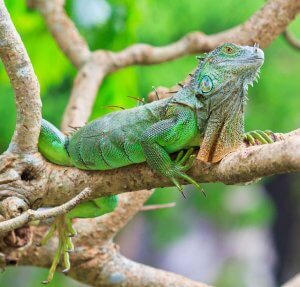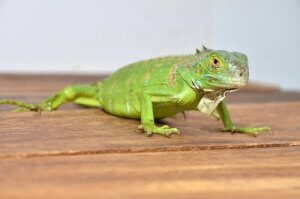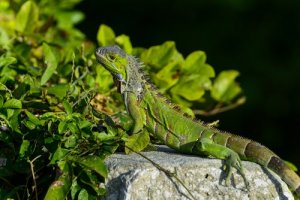Everything You Need to Know About Basic Iguana Care


Written and verified by the lawyer Francisco María García
Over the last few decades, the number of people interested in keeping reptiles as domestic pets has grown considerably. Iguanas are a great example. In today’s article, we’ll tell you everything you need to know about iguana care.
Legal and responsible ownership
Domestic breeding of several species of reptile is prohibited in order to prevent and combat the trafficking of wild animals. The black market sale of animals is a sad reality in many countries around the world, and threatens the survival of many exotic species.
Furthermore, it’s important to remember that the keeping of endangered species in captivity is considered a crime. The owner may be subject to economic sanctions and legal penalties.
As a result, it’s important to do plenty of thorough research in order to find a reputable breeder, and verify where their animals have come from.

Things to keep in mind before choosing an iguana as a pet
The iguana belongs to the reptile family, and is the most common species of lizard found in captivity. They usually live around 20 years if looked after properly and given a healthy, balanced diet.
The iguana can drop its tail to escape predators, and regenerate it only once in its lifetime. However, the color and shine of its new tail won’t be exactly the same as the old one.
Iguanas have become very popular pets in America and Asia, but they might not be the best option for new reptile owners. They’re fairly large, require a very specific diet, and can become very territorial as adults.
The financial aspect also plays an important role, as iguanas can be expensive pets. And it’s not just the initial investment of acquiring your pet legally. The expenses just keep on coming, with specialist veterinary care, vitamins and supplements.
There’s one last important aspect to keep in mind before deciding whether or not to buy an iguana. Reptiles are highly independent animals, and it’s this trait that allows them to survive in the wild. However, this means that you shouldn’t buy an iguana expecting it to be affectionate and want lots of cuddles!
Basic iguana care: choosing the ideal vivarium
The first thing you need to know about basic iguana care is how to set up their vivarium. This means reproducing optimal conditions to allow your pet to be happy and healthy.
Step one is to choose the right vivarium for your iguana. We wouldn’t recommend letting your pet roam loose around the house, especially at first, as they need time to adjust to their new home.
Adult iguanas can measure anywhere between 5ft 9″ and 6 ft 5″ in length. Baby iguanas, on the other hand, usually measure around 8 inches. This means that the vivarium you buy should be big enough to adapt to their rapid growth.
Every animal needs to have enough space to move around freely and get plenty of exercise. This is fundamental for ensuring they maintain a healthy weight, and to avoid them contracting a variety of different illnesses.
As such, experts recommend that the vivarium should be at least 4 times as large as the size of an adult lizard.
The right climate for a domestic reptile
Iguanas are native to tropical climates with large amounts of sunlight, and high humidity levels. As a result, they don’t hibernate.
If you want to keep an iguana in captivity, you need to create a suitable microclimate, especially in the winter.
The ideal climate for your reptilian friend should have 70 – 80% humidity. Ideally, it should also have a small swimming pool or artificial lake where your iguana can cool off, stay hydrated and express their natural behavior. Iguanas have a habit of climbing trees and jumping in water when they sense danger.
The temperature should sit at around 86 – 104 °F, decreasing slightly in winter. In the cooler months, the temperature should stay between 77 and 95 °F. It’s also important for the temperature to vary slightly from day to night.
Diet: a key part of iguana care
The majority of illnesses that affect iguanas kept in captivity are caused by poor nutrition. As a result, diet is a key part of basic iguana care.

Remember, iguanas are strictly vegetarian. They don’t eat any kind of animal protein, and much less raw meat.
Diet
- Green vegetables should represent 60% of their diet. Great choices include broccoli, endives, collard, carrot leaves, cauliflower, cress, parsley, spinach, escarole, celery, cabbage and arugula.
- Legumes should make up 25% of their daily diet. Ideally, this should include a mixture of corn, carrots, beetroot, sweet potato, and peas.
- Fruit represents 15% of their diet. This should be a mixture of tropical fruit, including apples, pears, peaches, bananas, oranges, papaya, mango, melon, watermelon, figs etc.
- Calcium in captivity. Iguanas may need to take calcium supplements to complement their natural diet.
Over the last few decades, the number of people interested in keeping reptiles as domestic pets has grown considerably. Iguanas are a great example. In today’s article, we’ll tell you everything you need to know about iguana care.
Legal and responsible ownership
Domestic breeding of several species of reptile is prohibited in order to prevent and combat the trafficking of wild animals. The black market sale of animals is a sad reality in many countries around the world, and threatens the survival of many exotic species.
Furthermore, it’s important to remember that the keeping of endangered species in captivity is considered a crime. The owner may be subject to economic sanctions and legal penalties.
As a result, it’s important to do plenty of thorough research in order to find a reputable breeder, and verify where their animals have come from.

Things to keep in mind before choosing an iguana as a pet
The iguana belongs to the reptile family, and is the most common species of lizard found in captivity. They usually live around 20 years if looked after properly and given a healthy, balanced diet.
The iguana can drop its tail to escape predators, and regenerate it only once in its lifetime. However, the color and shine of its new tail won’t be exactly the same as the old one.
Iguanas have become very popular pets in America and Asia, but they might not be the best option for new reptile owners. They’re fairly large, require a very specific diet, and can become very territorial as adults.
The financial aspect also plays an important role, as iguanas can be expensive pets. And it’s not just the initial investment of acquiring your pet legally. The expenses just keep on coming, with specialist veterinary care, vitamins and supplements.
There’s one last important aspect to keep in mind before deciding whether or not to buy an iguana. Reptiles are highly independent animals, and it’s this trait that allows them to survive in the wild. However, this means that you shouldn’t buy an iguana expecting it to be affectionate and want lots of cuddles!
Basic iguana care: choosing the ideal vivarium
The first thing you need to know about basic iguana care is how to set up their vivarium. This means reproducing optimal conditions to allow your pet to be happy and healthy.
Step one is to choose the right vivarium for your iguana. We wouldn’t recommend letting your pet roam loose around the house, especially at first, as they need time to adjust to their new home.
Adult iguanas can measure anywhere between 5ft 9″ and 6 ft 5″ in length. Baby iguanas, on the other hand, usually measure around 8 inches. This means that the vivarium you buy should be big enough to adapt to their rapid growth.
Every animal needs to have enough space to move around freely and get plenty of exercise. This is fundamental for ensuring they maintain a healthy weight, and to avoid them contracting a variety of different illnesses.
As such, experts recommend that the vivarium should be at least 4 times as large as the size of an adult lizard.
The right climate for a domestic reptile
Iguanas are native to tropical climates with large amounts of sunlight, and high humidity levels. As a result, they don’t hibernate.
If you want to keep an iguana in captivity, you need to create a suitable microclimate, especially in the winter.
The ideal climate for your reptilian friend should have 70 – 80% humidity. Ideally, it should also have a small swimming pool or artificial lake where your iguana can cool off, stay hydrated and express their natural behavior. Iguanas have a habit of climbing trees and jumping in water when they sense danger.
The temperature should sit at around 86 – 104 °F, decreasing slightly in winter. In the cooler months, the temperature should stay between 77 and 95 °F. It’s also important for the temperature to vary slightly from day to night.
Diet: a key part of iguana care
The majority of illnesses that affect iguanas kept in captivity are caused by poor nutrition. As a result, diet is a key part of basic iguana care.

Remember, iguanas are strictly vegetarian. They don’t eat any kind of animal protein, and much less raw meat.
Diet
- Green vegetables should represent 60% of their diet. Great choices include broccoli, endives, collard, carrot leaves, cauliflower, cress, parsley, spinach, escarole, celery, cabbage and arugula.
- Legumes should make up 25% of their daily diet. Ideally, this should include a mixture of corn, carrots, beetroot, sweet potato, and peas.
- Fruit represents 15% of their diet. This should be a mixture of tropical fruit, including apples, pears, peaches, bananas, oranges, papaya, mango, melon, watermelon, figs etc.
- Calcium in captivity. Iguanas may need to take calcium supplements to complement their natural diet.
This text is provided for informational purposes only and does not replace consultation with a professional. If in doubt, consult your specialist.








